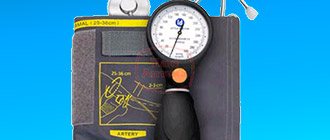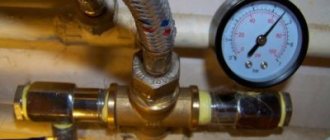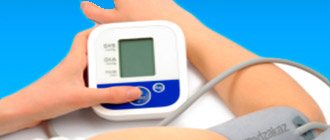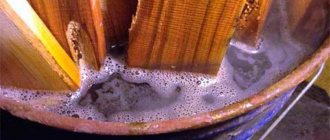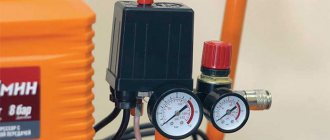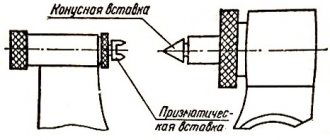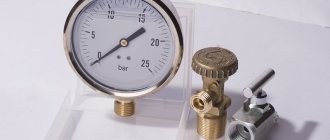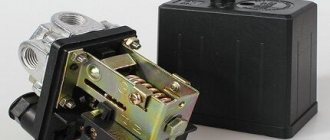Pressure gauges for measuring gas pressure: types, design features and operation of meters Often there is a need to measure the pressure created by gas. For example, in cylinders, in gas pipelines, in various containers and vessels. To control and monitor indicators, pressure gauges are used to measure gas pressure. These devices serve in various spheres of life, from medicine to heavy industry.
To ensure that the purchase of the device is not in vain, and that the purchased pressure gauge meets the requirements of production processes, it is worth familiarizing yourself with the classification. We will introduce you to the types of gas pressure meters. Let's talk about their design features and operating principles.
Content
From previous lessons we know that barometers - mercury and aneroids - are used to measure atmospheric pressure.
But how to measure air pressure, which differs significantly in value from atmospheric pressure? There are also special devices for this, which will be discussed further.
Scope of use
The devices are installed wherever it is necessary to control the pressure level in order to avoid emergency situations and disruptions of technological processes:
The devices are used in all cases where it is necessary to know, control and regulate the pressure of water, other liquids, gases, and steam. It is difficult to name an industry that can do without this. Most often, pressure gauges are used in heat power engineering, chemical and petrochemical plants, and in the food industry.
The purpose of a liquid pressure gauge depends on the device, but they are used less and less often, since there is a possibility of it spilling and splashing out during a sharp surge in pressure.
Liquid pressure gauge
The open liquid manometer device is a two-legged glass tube filled with liquid. Since only atmospheric pressure acts on the surface of the liquid, the liquid is established at the same level.
A rubber tube is attached to one end of the glass tube and connected to a flat box covered with rubber film. What happens if we press our finger on the film? Figure 2 shows that the liquid level in the pressure gauge elbow, which is connected to the rubber tube, will decrease.
Figure 2. Open liquid pressure gauge.
Let's remember Pascal's law: the pressure exerted on a liquid or gas is transmitted to any point without changes in all directions. This means that when we pressed the film, we increased the air pressure in the box.
Since the box is connected to the elbow of the glass tube, pressure is transferred to the liquid in this elbow (let’s call it “first”), that is, the pressure in the first elbow will be greater than the pressure in the other, because only atmospheric air pressure acts on that elbow.
The liquid will come to equilibrium and stop when the excess pressure in the first bend equals the pressure of the excess liquid column in the other.
The pressure exerted on the film will depend on the force of pressing: the harder we press, the higher the excess column of liquid will be. This means that the change in pressure can be associated with the height of this excess column.
With the help of a liquid pressure gauge we can measure pressure in liquids. Pay attention to Figure 3.
Figure 3. Measuring fluid pressure using a fluid pressure gauge.
The design of the pressure gauge has not been changed, but we can immerse a box covered with film in a container of water. From experience it is clear that the deeper the box is, the greater the difference in height of the liquid in the pressure gauge elbows becomes . We can say that the more pressure the liquid produces in the container.
What if we turn the box in different directions at the same depth? And again, Pascal’s law will help us answer this question: the pressure gauge readings will not change, because the pressure in all directions at the same depth/height is the same.
Take a look at Figure 4. This is what a liquid pressure gauge looks like in real life.
Figure 4. Realistic image of a liquid pressure gauge.
Division by functional purpose
According to their intended purpose, the following types of pressure gauges used to measure gas pressure are distinguished:
- general technical;
- reference;
- special.
Let's look at the features of each type.
Pressure gauges for general technical purposes
This type of pressure gauges is produced for the purpose of measuring vacuum and excess pressure values for general technical purposes. Various modifications of the devices allow them to be used in a wide variety of environments. They are used to measure pressure in production directly during technological processes.
The pressure in such devices acts on the tube from the inside and causes the loose end to move. A mechanism interacts with it that moves the arrow
Such pressure gauges can measure the pressure of gaseous media that are non-aggressive towards copper alloys at operating temperatures up to 150 °C. Typically, the body of the product is made of steel, and the mechanism parts are made of brass alloy.
General technical pressure gauges for low or high pressure gas are manufactured to be resistant to vibrations with a frequency in the range from 10 to 55 Hz, as well as a displacement amplitude of a maximum of 0.15 millimeters. They have several accuracy classes from 1 to 2.5.
Digital pressure gauges are small in size, characterized by high measurement accuracy and long service life. Moreover, such devices can be calibrated
Gas pressure gauges for general technical purposes with an electronic board on which the measurement data are displayed are gaining popularity. They are often equipped with converters, which automates technological processes. Pressure values are displayed on an electronic dial.
Group of special pressure gauges
Such devices are manufactured for a specific type of gas and the environment it creates. For systems with increased pressure, pressure gauges are made for high-pressure gas. Some gases are aggressive towards certain alloys, so it is necessary to use resistant materials when working with them.
Special pressure gauges are painted in different colors depending on the type of gas.
Propane pressure gauges are painted red, have a steel body and have the characteristics of general technical pressure gauges. The operating pressure of such devices is from 0 to 0.6 MPa. This is standard propane pressure. Operation is possible in the temperature range from – 50 to + 60 °C. Working environment temperature up to + 150 °C. Often included with balloon reducers.
Ammonia pressure meters in cylinders and other containers are colored yellow. Units with multi-stage compression are equipped with a temperature scale. The pressure gauge components are made of materials resistant to ammonia vapors.
In the presence of serious dynamic loads, pressure gauges are filled with glycerin or silicone
The acetylene pressure gauge is painted white. Manufactured as a pressure gauge for security systems from fat-free materials. Used to measure excess pressure in various acetylene distribution and generating systems. The body is made of steel, the internal components are made of brass alloy. The permissible temperature range is from – 40 to + 70 °C.
The hydrogen pressure gauge turns dark green. The pressure gauge for other flammable gases is painted red. The measuring device for non-flammable mixtures is painted black. The oxygen pressure gauge is painted blue.
Metal pressure gauge
You have already seen the appearance of a metal pressure gauge in Figure 1. Let us now consider its internal structure, which comes in two main types. The first is shown in Figure 5.
Figure 5. Design of metal pressure gauge No. 1.
A curved hollow tube 1, sealed at one end, is connected on the other side to a tap 4, which communicates with the vessel in which the pressure needs to be measured.
As the pressure increases, tube 1 begins to unbend, and with the help of lever mechanism 5 and gears 3 transmits movement to pointer 2, which moves along the scale of the device.
Tube 1 is elastic, and when the pressure decreases, it returns to its original position, and the pointer returns to the zero scale division.
Figure 6 shows a slightly different type of metal pressure gauge.
Figure 6. Design of metal pressure gauge No. 2.
The difference in structure is only that the tube is sealed on both sides, but has an outlet for connection to the vessel in which the pressure needs to be measured. There are also two rods (levers) 2.
Note that, despite slight differences in the device (Figures 4 and 6), the principle of operation of metal pressure gauges remains the same.
The actual appearance of the metal pressure gauge is shown in Figure 7.
Figure 7. Realistic image of a metal pressure gauge.
Classification by operating principle
Gas pressure gauges, depending on the mechanism for reading readings, are divided into:
- Deformation;
- Electrical;
- Deadweight piston;
- Liquid.
Each type has its own characteristic features.
Deformation type of pressure gauges
The principle and basis of operation of deformation class devices is that pressure acts on the sensitive element of the device, which is deformed. The level of pressure is determined by the degree of deformation.
Deformation pressure gauges are produced with tubular-spring, bellows or membrane working components with high sensitivity
The sensing elements in tubular-spring devices are tubular springs. These products are tubes bent in a circle with a transverse oval section. The gas affects the inner surface of the tube. During this exposure, the tube is deformed and changes its shape, approaching roundness.
One end of the tube is sealed and can be moved. The second is open and fixed with holders. When the spring tube is bent, the rings are also affected, which then unbend the spring. The sealed end of the spring moves in accordance with the pressure force. This movement is transmitted to the measuring scale.
When measuring pressures up to 40 bar, circular springs are used. At higher pressures, helical or spiral springs located in the same plane are used. The error of readings when measuring pressure using this method ranges from 1 to 4%.
Diaphragm and bellows sensing elements allow you to effectively measure small values of excess and vacuum pressure.
The bellows is made according to the principle of a plumbing bellows hose. It is a thin-walled metal tube made of movable transverse rings. Depending on the material and manufacturing parameters, the bellows can be more or less rigid.
Under the influence of high temperature, plastic deformations accumulate over time, which disrupts the accuracy of the readings. In addition, at elevated temperatures and pressure pulsations, the change in static characteristics accelerates
Sensitive membrane elements have the greatest variety. The accuracy class of such devices does not exceed 1.5. Such devices have a protective system. In case of overload, the membrane rests against a special protective device.
Membrane boxes are often installed in devices that measure pressure and vacuum. Pressure gauges, draft gauges and pressure gauges with membrane boxes are produced with accuracy classes 1.5; 2.5 and measurement limit up to 25 kPa.
Flat diaphragms have a small displacement of the operating point, so they are most often used to convert pressure into force. They are unstable, but well calculated.
Corrugated membranes, together with similar boxes, are used to improve static performance. The former move better, but are difficult to calculate. The latter are used much more often due to their reduced rigidity.
To measure small pressure values, devices with flaccid membranes are used.
Devices need protection from high temperatures, as it negatively affects the elasticity and sensitivity of the main working elements.
Mechanical indicating pressure gauges
Many tube spring gauges are actually direct conversion devices. This means that the pressure is converted into displacement of the sensing element and the mechanical device in contact with it.
In the diagram, the fitting is placed radially, but pressure gauges with an axial fitting are also produced
Under the influence of pressure, the free end of the spring moves, the driver acts on the gear sector, and the gear and the indicating arrow rotate.
Spring indicating pressure gauges are manufactured with a measurement range from 0.1 to 103 MPa and have various accuracy classes. Exemplary models are produced with accuracy classes of 0.15; 0.25; 0.4. Meters of the working category of increased accuracy - 1 and 0.6. General technical workers - with accuracy classes 1.5; 2.5; 4.
Electric contact pressure gauges
Structurally, it is a modification of the indicating pressure gauge. The essence of the work is that when the arrow reaches a threshold pressure value, the network closes.
The design of the indicating pressure gauge additionally has built-in arrows with pressed electrical contacts, which are located opposite the signaled values
The electrical circuit is closed and the alarm is triggered when the indicating arrow reaches one of the arrows with contacts. The accuracy class of such pressure gauges is 1.5. The measuring range corresponds to standard values.
To provide signaling or for the purpose of positional control, a pressure switch marked RD is used. They measure pressures in the range from 12 to 1600 kPa. The relay is adjusted to the upper and lower activation limits according to the readings of the control device, and it has a breaking power of 10 W.
Recording models of pressure gauges
The industry produces pressure gauges with a built-in indicator reading system, which records the values on a disk chart so that the dynamics of the indicators can then be monitored. One revolution can be completed in 8, 12, 24 hours. The movement occurs due to an electric motor or clock mechanism.
The operation of a pressure gauge recorder is based on the transmission of a signal by a large diameter tubular spring, which has a traction force. It transmits movement from the sensing element to the display system. Devices marked MTS record excess pressure values.
Such devices require operator control and have accuracy classes 1; 1.5; 2.5.
Bellows sensitive elements are used in self-recording differential pressure gauges, which can additionally be equipped with an alarm device and a pneumatic transducer. Such devices measure pressure in the range from 6.3 kPa to 0.16 MPa and have accuracy classes 1; 1.5.
Deadweight type pressure gauges
Such pressure gauges are often used as a standard when calibrating other measuring instruments. Their measurement range is very wide. Depending on the design of the device, it can start with serious vacuum values and end with redundancy of up to 2500 MPa. The accuracy class reaches maximum values up to 0.0015.
Every time a measuring device is exposed to a load beyond its normal limits, it loses its service life and measurement accuracy.
The principle of operation is to hold the cylinder in the piston in a specific state while calibration weights are applied on one side and the measured pressure is applied on the other. Depending on the weight of the loads, the amount of pressure created is judged.
The main working element of the device is the measuring column. Depending on the quality of its production, the accuracy and purity of the compounds, the magnitude of the error also changes.
PMGs operating on gas have the smallest measurement error. However, such devices cost many times more due to their design features and the need to filter gas from foreign particles
Functionally, a deadweight pressure gauge consists of a pressure creation device, a measuring system and weights. The device is equipped with a rotating mechanism for increasing and decreasing pressure, as well as a pressure relief valve.
Pressure gauges with an unsealed piston are widely used. They have a gap between the piston and cylinder. The container under the piston is filled with oil, which is poured into the gap under pressure and lubricates the rubbing surfaces.
Electrical gas meter
Such pressure gauges are used to convert direct or indirect gas pressure into an electrical parameter. The most common pressure gauges of this type are: strain gauge, capacitance and resistance devices. Pressure is measured in the range from 100 Pa to 1000 MPa. The devices are manufactured with accuracy classes from 0.1 to 2.5.
The operation of pressure gauges operating on the basis of the tensoresistive effect is to change the resistance value of the conductor due to deformation. They measure pressure in the range from 60 to 10 8 Pa with minimal error.
The flange mounting of the sensor and the special design of the device allows you to read pressure data in particularly aggressive environments with temperatures up to 300 °C. Used to measure pressure in systems with fast-flowing processes.
The operating diagram of resistance pressure gauges is based on the dependence of conductor resistance on pressure. Typically, this type of device is used to measure particularly high pressure levels above 100 MPa
The sensitive element in such a device is a manganin wire, the resistance of which is easily measured by a balanced bridge.
The operation of capacitive pressure gauges is based on the effect of pressure on a membrane, which is a movable electrode. When the membrane moves, a change in the capacitance of the transducer follows. Characterized by significant temperature errors.
In capacitive pressure gauges, the deflection of the membrane is determined by an electrical circuit. Such devices are used in systems with rapid pressure changes.
Liquid measuring instruments
Pressure is determined by these devices by balancing the detected pressure with the pressure formed by the liquid column. In this way, you can measure small excess pressure, atmospheric pressure, vacuum level, pressure difference.
This group is represented by U-shaped pressure gauges, which consist of communicating vessels, and the pressure is determined by the liquid levels; compensation micromanometers; cup pressure gauges, which use a reservoir instead of a second tube; float, bell and ring differential pressure gauges.
Double-pipe pressure gauges allow you to measure pressure differences. In this case, pressures that need to be measured are applied to each of the tubes
In liquid measuring instruments, the working fluid is an analogue of the sensitive element.
Differential pressure gauges are usually equipped with alarms, flow meters, regulators and recording devices. Measurement range from 10 to 10 5 Pa. Depending on the liquids filling the device, the measurement limit changes.
Operating principle
The simplest mechanical pressure gauge works as follows: the main part is a Bourdon tube, which moves the needle when air pressure is applied. When connected to the valve, air pressure acts on the brass tube, which tends to straighten, due to which the other end of the tube acts on the rod, moving the arrow. A similar principle of operation also applies to a membrane pressure gauge.
An electronic pressure gauge is more complex; a sensitive element is used as a meter, the readings of which are transmitted to an electronic board and then to the display.
What does it show and what does it measure?
A car pressure gauge is a device that shows the density of the air inside a tire. Unit of measurement kgf/cm² or Bar. The measuring device can also be used to measure pressure in air suspension cylinders. Ready-made pneumatic kits are often equipped with dial gauges from a KamAZ vehicle, since it has a mechanical dial gauge that shows pressure up to 10 atmospheres and is distinguished by the accuracy of the indicators. The principle of operation of the pressure gauge for tires and air suspension is the same, since they work on the same principle.
What is a pressure gauge for? First of all, for safety. In previous articles, we touched on the topic of tire pressure differences and what this leads to (uneven tire wear, increased driving hazards, increased fuel consumption). Often the device is integrated into a pump, be it mechanical or electrical, but to read tire pressure, the pump must be securely attached to the valve, which is completely inconvenient.
Advantages of working with pressure gauges
What is a pressure gauge for? First of all, this is an indispensable assistant for every car enthusiast, especially for those who often use the vehicle to drive on sand and off-road, where pressure relief or pumping is required.
How to use a pressure gauge? It’s quite simple: you need to insert the fitting into the tire valve, after which the gauge needle will show the real pressure. The digital device must first be turned on. By the way, in order not to constantly check tire inflation, there are special valves with pressure sensors. The simplest sensors are equipped with nipples with three-color divisions: green - the pressure is normal, yellow - requires pumping, red - the tire is flat.
There are also ready-made systems with an LCD display that is installed in the cabin, notifying 24/7 about the status of tire pressure. Most modern cars are already equipped with a standard tire pressure information system, and SUVs have a function for pumping up or deflating pressure. One way or another, it is extremely important to have a pressure gauge with you, since the correct tire pressure is the key to safe and comfortable driving.
Conversion of pressure gauge units
There is often a need to measure non-standard pressure values. Non-standard scales are used on professional pressure gauges, but they are more expensive. Here's how to convert non-standard units of measurement into the metrics we are used to.
In one kgf/cm2 there are 10,000 kgf/m2, one atmosphere, one bar, 0.1 MPa, 100 kPa, 100,000 Pa, 10,000 millimeters of water column, 750 millimeters of mercury or one thousand mbar. You can create the required scale with the appropriate symbols yourself.
What should you consider when choosing a pressure gauge?
Before purchasing new equipment, there are several important parameters to consider. This is not necessary if a specific modification is used for use in a specific situation and is commercially available. It is necessary to take into account special parameters if the original is not on sale, but its analogue is selected.
Measuring range parameter
Perhaps this is one of the most important parameters by which new pressure gauges are selected. The standard range of pressure gauges includes the following values (kg/cm2):
- 0-1;
- 0-1.6;
- 0-2.5;
- 0-4;
- 0-6;
- 0-10;
- 0-16;
- 0-25;
- 0-40;
- 0-60;
- 0-100;
- 0-160;
- 0-250;
- 0-400;
- 0-600;
- 0-1000.
In one kg/cm20.9806 bar or 0.09806 MPa.
For pressure and vacuum gauges, the standard range of values (kgf/cm2):
- From -1 to +0.6;
- From -1 to +1.5;
- From -1 to +3;
- From -1 to +5;
- From -1 to +9;
- From -1 to +15;
- From -1 to +24.
One kgf/cm2 contains two atmospheres (or bar), 0.1 MPa.
For vacuum gauges, the standard range is -1 to 0 kilogram-force per square centimeter.
If there is any doubt about what scale should be on the device, it is necessary to ensure that the operating pressure is between 1/3 and 2/3 of the scale. For example, if the measured pressure should be 5.5 atmospheres, then it is better to take a device that measures up to ten atmospheres at its maximum value.
If the measured pressure is less than 1/3 of the scale division, the device will display inaccurate information. If you buy a device whose maximum value is close to the measured pressure, then during the measurement process the pressure gauge will work under conditions of increased load and will quickly fail.
Accuracy class parameter
In other words, this is the error parameter allowed by the manufacturer of a particular equipment model. The standard list of accuracy classes includes models with the following parameters:
- 4;
- 2.5;
- 1.5;
- 1;
- 0.6;
- 0.4;
- 0.25;
- 0.15.
Naturally, the smaller the error of the device, the higher its cost. If the accuracy class specified by the manufacturer does not comply, the device cannot be used as it will show incorrect data. You can find out about this discrepancy as follows. For example, the maximum value on the scale is set at 10 atmospheres. The device has an error class of 1.5. that is, a 1.5 percent mismatch of parameters is acceptable. This means that the permissible deviation on the scale is possible (in this case) by 0.15 atm.
The arrow indicates the error class of the pressure gauge
It is impossible to calibrate or test the device at home, since this will require a reference device with minimal error. To check for serviceability, these pressure gauges are connected to one line. Pressure is supplied through it, and the indicators of the devices are compared.
Pressure gauge diameter parameter
This characteristic is of great importance for models with a round case and a corresponding scale. The larger the diameter, the more marks can be made and more accurate parameters can be determined.
The list of standard diameters (in millimeters) of pressure gauges includes:
- 40;
- 50;
- 63;
- 80;
- 100;
- 150;
- 160;
- 250.
Connection location
The position of the measuring port is also of great importance. There are models with:
- Radial arrangement. In this case, it is located at the bottom of the device under the scale. This makes it easy to measure pressure parameters in cavities that are difficult to access. An example of this is car wheels;
- End location. In this case, the fitting is located on the back of the device.
Depending on the measurement conditions and the characteristics of the measuring fittings on the line or tank, the appropriate model is selected. This is necessary so that the fitting fits as tightly as possible to the measuring hole of the container.
Connecting thread
Most pressure gauges are equipped with metric and pipe connecting threads. The standard sizes are:
- M10*1;
- M12*1.5;
- M20*1.5;
- G1/8;
- G1/4;
- G1/2.
Domestic pressure gauges are sold with a metric connection thread. Imported analogues - with pipe threads.
Calibration interval
This is the interval at which equipment must be verified. When purchasing a new pressure gauge, it is already calibrated (at the factory). This is indicated by the corresponding sticker. Professional equipment requires such verification. If you purchase an option for domestic use, then this procedure is not necessary.
Primary verification of equipment for departmental companies is valid for one or two years (depending on the characteristics of the company). This procedure is performed by licensed companies. Often you have to spend more money on re-verification than on purchasing new equipment.
For this reason, if there is a need to use a verified pressure gauge, it is more practical to purchase an option with a two-year initial verification. When the time comes to perform re-verification, you need to calculate how much this procedure will cost, including putting the device into operation and, if necessary, repairs.
If the system in which the pressure gauge is installed frequently experienced water hammer or was subjected to other high loads, then after two years of operation half of the equipment does not pass verification, and you still need to pay for the procedure.
Operating conditions for pressure gauges
This is another factor that you need to consider when choosing a new pressure gauge. In case of operation in conditions with increased load due to exposure to viscous or aggressive substances, constant vibrations, as well as extreme temperatures (exceeding +100 and below -40 degrees), it is necessary to purchase specialized equipment. Typically, the manufacturer specifies the ability of the pressure gauge to operate under such conditions.
How are pressure gauges checked?
As we have already noted, there is an initial and repeated verification of pressure gauges. The primary procedure is carried out at the manufacturing stage before its sale. Typically, verification is valid for one to two years. This period will be indicated on a label stuck on the device body or in its passport.
After this period has expired, the device requires re-verification. In this case it should be fine. If there are doubts about this, then it is better to buy a new pressure gauge, because funds for checking the serviceability of a non-functional device are not refundable.
To conclude the review, we offer the TOP 5 pressure gauges for 2022:
TOP-5. The best pressure gauges. Rating 2022!
